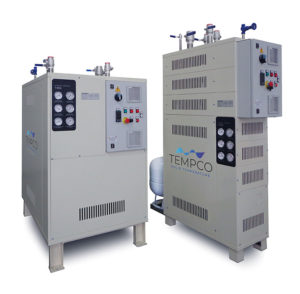Thermoregulating units selection
A thermoregulating unit is a system used to supply a fluid at a certain temperature in an automatically and constantly controlled way. It is aimed to ensure a fine temperature regulation required in such sectors as rubber and plastic industry, chemical and pharmaceutical industries, but also in power generation and gas compression.
Moreover, this kind of temperature control is usually required in any industrial field needing a fine temperature regulation of the process fluids (for example, in order to trigger specific chemical reactions or to be able to employ certain substances within the production process).
The thermoregulation of an industrial process is a task that involves heating and cooling cycles, that the system alternates based on the temperature variations generated by the various steps of the production cycle. In order to maintain a certain temperature, which is strictly required to ensure the quality of the final product, the unit thus launches different function changes:
- Heating
- Cooling
- Maintaining
Thermoregulating units are therefore equipped with sensors and probes (thermostats, flowmeters, pressure gauges and overpressure valves) aimed to continuously measure temperatures and other physical conditions of the process. Units are also equipped with heating resistors, cooling exchangers and PID electronic temperature controllers, ensuring both in heating and cooling cycle a constant and precise control of temperatures, very often at high levels.
Based on the level of temperatures a thermoregulating unit is aimed to manage, the unit can operate using different fluids, that have to be selected based on their physical properties. The fluids most commonly employed in thermoregulating units, due to the fact that they allow to operate in the majority of conditions, are:
- Hot water, up to 90° C
- Over-heated water, up to 140° C
- Diathermic oil, up to 350° C
A thermoregulating unit is a perfect example of what in Tempco is called SCF, Standard Custom Flexibility, that stands for solutions that can be standardized at maximum levels in order to offer affordable costs to the customer combined with customization to fit the specific needs of his process. Each and every order has indeed its history and specific features, in terms of temperature ranges and set-points to guarantee or also in terms of certifications (Atex, PED, Gost, Rina).
Heating and cooling cycles can be achieved with different systems:
HEATING
- Armored electric resistors
- Steam
- Diathermic oil
- Pressurized water
COOLING
- Water
- Non-freezing solutions
- Air
- Nitrogen
This kind of thermostatation machinery employs simple PID temperature controllers, but in case of more complex needs there are more sophisticated systems that are used, using a PLC. These are local control systems that enable automatic and remote management of the hardware equipments that serve the heating and cooling cycles, based on parameters and set points configured.
Recently, the development of global systems with growing complexity led to an increasing demand for systems able to manage and control remotely the process and its parameters, allowing the local management of machines and hardware but also an efficient and pro-active condition monitoring. This enables a real-time management and optimization. Nowadays these systems can also use innovative technologies such as IoT and big data analytics, such as out iTempco IoT platform, bringing efficiency, optimization and business intelligence within the production.
The STB TREG Smart Thermoregulating Box series has been developed specifically to answer this kind of need. These are classical thermoregulating units that, leaving behind the usual local management systems (but clearly maintaining in local all the security equipments), rely on the smart transmission of data enabled by intelligent terminals, in order to be able to completely manage all the temperature set-points and parameters from a remote station, actually realizing real thermoregulation networks.
Thinking about energy saving, embracing the principle that the first energy that gets saved is the energy which is not generated, is it also possible to design thermoregulating units that employ waste thermal energy, coming for example from exhaust generated by the production process, that can be used to heat and thermoregulate fluids at lower temperatures, avoiding the use of electric heating sections and eliminating the related energy consumption.




 Back to index
Back to index Download the complete book
Download the complete book